
Supporting all people to engage in activities they find meaningful AUTUMN 2024 | VOL 21 ISSUE 1 Print Post Approved PP340742/00147 ISSN 1832-7605 OTA’s New Strategic Plan The Value of Experiential Learning and Lived Experience Tina Champagne is Coming This June! My Burnout Story Progress, Pride, Empowerment, and Connection DISCOVER STORIES FROM YOUR PEERS







ABOUT CONNECTIONS
Connections is a publication of Occupational Therapy Australia (OTA), the peak body representing occupational therapy in Australia.
CONTACT US
Occupational Therapy Australia
ARBN 007 510 287
ABN 27 025 075 008
5/340 Gore St, Fitzroy, VIC 3065
T: 1300 682 878
E: info@otaus.com.au
W: www.otaus.com.au
CONTRIBUTIONS
Connections welcomes article submissions, email communications@otaus.com.au
Attention: Connections Editor
ADVERTISING
Please contact advertising@otaus.com.au for advertising enquiries
DESIGN
Perry Watson Design
COVER
gettyimages/Marisvector
DISCLAIMER
This newsletter is published as an information service and without assuming a duty of care. It contains general information only and, as such, it is recommended that detailed advice be sought before acting in any particular matter. The materials included in this newsletter by third parties are not attributable to Occupational Therapy Australia, and are not an expression of Occupational Therapy Australia’s views. Occupational Therapy Australia is not responsible for any printed expressions or views in any third parties’ inclusions. Any enquiries regarding inserts, advertisements or articles placed by these third parties should be directed to them.
Occupational Therapy Australia respectfully acknowledge the Traditional Custodians of the country on which we live, learn and work.

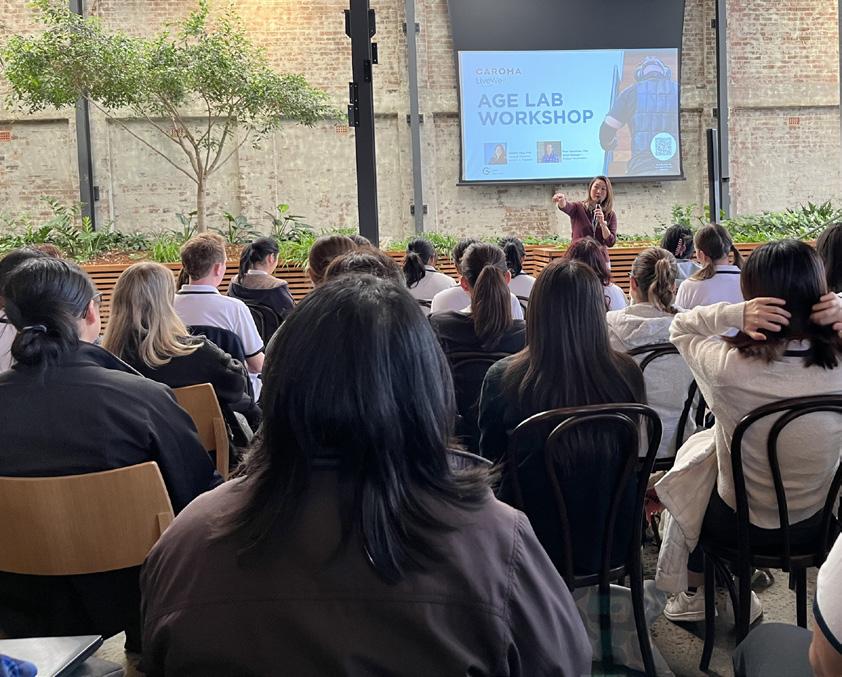
CONNECTIONS AUTUMN 2024 3 CONTENTS FEATURES 10 My Burnout Story 14 The Value of Experiential Learning and Lived Experience Within OT Training 16 OTA’s New Strategic Plan 18 Tina Champagne is Coming This June! 19 Diversity, Equity & Inclusion: How to find blind spots in your OT practice 24 Business Insurance 101: Important things you need to know NEWS 04 President’s Report 05 CEO’s Report 06 Quarterly Update – Member News 13 WFOT Update 22 AOTJ Update 10 My Burnout Story
14 The Value of Experiential Learning and Lived Experience Within OT Training

WPresident’s Report
Priscilla Ennals | OTA President
elcome to this latest edition of Connections. It is an honour to take on the role of President of OTA and I am excited about the year ahead. I want to start by thanking Carol McKinstry for her leadership of the Board over the last four years, and each of the Board members I have served alongside since 2019, all of whom have been fabulous role models, mentors and guides to me.
In my new role as President, I look forward to connecting with more of you. I want to hear about you, your careers, your needs and wants as members; your challenges and uncertainties as OT professionals; and your hopes for the profession. In this spirit of connecting, I would like to share a little about myself. I live in Melbourne with my husband Tim, three teen/adult daughters Freya, Tess, and Stella, and my two oodle dogs, Dusty and Alfie. I grew up near Cobram in northern Victoria on a dairy farm with parents who fostered an ethic of hard work and giving back to community.
I studied occupational therapy at Lincoln Institute/La Trobe University, graduating in 1990. During the course, I started to understand the connection between wellbeing and occupation. I clearly remember some of the people I met on fieldwork placements and my instant fascination with mind, body, doing, environment, and context (historic and current).
My first jobs were with the MS Society and then at an acute ward in a psychiatric institution; they were times of rapidly trying to work out what occupational therapy was and who I was as an occupational therapist. Since then, I have worked in
I clearly remember some of the people I met on fieldwork placements and my instant fascination with mind, body, doing, environment and context (historic and current). Learning, and unlearning, have been constants over my career.
community mental health roles in the city, the country and in the UK. I then moved into academia where I discovered a love of teaching. While not planned, this move made sense, as my family has a long line of skilled and dedicated teachers and teaching was an occupation that felt very familiar.
Delving back into occupational therapy theory made a whole lot more sense after experience in the field, and debating ideas with students was fun and rewarding. I learnt much from the many students I connected with, as I did, and do, from the many people I have supported in different mental health roles. Learning, and unlearning, have been constants over my career.
I now work with a national community mental health provider, in a role where I manage research and evaluation. It is a privilege to support the organisation to reflect, learn and try new things, all with the intention of supporting people’s mental health and wellbeing.
OTA’s new approach to strategy has been a labour of love over the last two years (most
of the time!) by the OTA Board and the team at OTA, in collaboration with many of our members and stakeholders. We have thought hard about conditions in and outside of the profession and the multitude of factors that will shape our future context. We have practiced holding immediate and emergent conditions in mind as we make decisions that align with our values and consider our strategic opportunities and risks.
We are proud to share the new strategic pillars with you in this edition – Progress, Pride, Connection and Empowerment. This foundation will drive and integrate OTA’s activities as we continue to deliver for the profession and for the people and communities that occupational therapists serve. You can read the new strategy on pages 16-17.
Alongside the hope and optimism we hold, we know that challenge, distress, and uncertainty are realities for many people and many members right now. We hope to stay connected to hear about these and to act in meaningful ways where we can. Keep connecting.
4 otaus.com.au PRESIDENT’S REPORT
CEO’s Report
Samantha Hunter | OTA CEO
Welcome to another edition of Connections, and a particularly warm welcome to our new President Priscilla Ennals.
Celebrating 80 years of OT in Australia
This year we celebrate 80 years of occupational therapists being represented as a profession by an association. Originally formed in 1944, The Occupational Therapists Club was the first gathering of OTs to support each other and to discuss and develop the profession. This would quickly evolve a year later into the Australian Association of Occupational Therapists (AAOT) – just in time to meet the needs of an influx of returning veterans from World War II.
State and territory chapters followed –Victoria in 1947, Queensland and New South Wales in 1948, Western Australia in 1953, South Australia in 1963, Tasmania in 1971, ACT in 1979 and the Northern Territory in 1986. The Federal Association incorporated all state and territory members and in 2009, national members voted to transform the AAOT into a truly national association, which we now know as Occupational Therapy Australia. This year, we will reflect on the long and honoured traditions of occupational
therapy, and work to enact an ambitious plan that speaks to the future and grows the significance and impact of the profession.
Moving into the future
Over recent years, OTA’s Board and leadership team have set solid foundations to enable the association to continue evolving to meet the profession’s and the communities’ needs for the future. Late last year, the Board of Directors settled the new strategic plan for our future, which you will see set out in this edition (see pages 16-17). At the Annual General Meeting, members voted on a motion to appoint two remunerated non-member directors, as per our constitution. The Board also signaled to the membership that this year would see a review of our current constitution, to bring it into line with contemporary governance standards. We look forward to seeking member input into changes prior to a member vote at our Annual General Meeting of 2024.
With a focus on our strategic pillars of Progress, Pride, Connection and Empowerment, the association has been working with members and a new design agency to re-imagine how OTA might visually embrace our new outward looking strategy.
As we reflect on the proud 80-year history of connection and unity of the professional association, I look forward with optimism and energy to our shared future.

The strategy will focus not only on our membership and the broader profession but also embrace all who use occupational therapy – the consumers and carers, as well as our allies and partners and those who we seek to influence and engage with.
The scene is set for a busy year, but an exciting and productive one. We look forward to another transformative Leadership Program starting in May, an enlightening OT Exchange in Perth in June, and an expanded Mental Health Forum in November.
As we all continue to operate in a challenging environment with the rising cost of living, unsettling global conflicts and some uncertainty around major funding schemes, I do think there’s room for optimism. We are a strong, resilient and adaptable profession which is much in demand. Despite political uncertainty around schemes’ futures, Australia is committed to social democracy and providing societal safety nets.
While we may need to shift our thinking in ways of delivery, there is sufficient impetus and influence from the association, and from consumer groups, to ensure that the deck chairs may be shuffled, but they will not be thrown overboard. Unity through community was last year’s OT Week theme. I see this mindset every day as we unite as a profession behind the association to provide one strong voice, and walk forward with our clients, consumers and partners as we face the challenges ahead.
As we reflect on the proud 80-year history of connection and unity of the professional association I look forward with optimism and energy to our shared future.
CONNECTIONS AUTUMN 2024 5 CEO’S REPORT
Quarterly Update – Member News
Policy, advocacy and representation: what we’ve been doing for members
Occupational Therapy Australia has continued to advocate to further the interests of occupational therapists, with a particular focus on advancing issues that sit within our key strategic areas. During the past three months we have focused on:
1. Working to influence the Federal Government’s budget priorities
2. Continuing to represent occupational therapists in the NDIS space
3. Liaising with the Department of Health and Ageing to inform psychosocial support models.
Thank you to all the members who have supported our advocacy efforts during the past quarter by sharing your experience and perspectives with us.
Welcome to our newest team member
We would like to warmly welcome Sarah Amaterstein to the Government and Stakeholder Relations team. Sarah is OTA’s new Stakeholder Advisor and comes to us from the Continence Foundation, where she worked in stakeholder relations, policy, and advocacy.
Influencing the Government’s budget priorities
In late 2023 we turned our attention to the upcoming 2024-2025 Federal budget and have been working to influence the Government’s budget priorities. We have noted an inherent synergy between OTA’s priorities and the Government’s reform
agenda – specifically in preventative health and person-centred care. OTA has developed a pre-budget submission which highlights five key areas for Government attention, which we believe will support the role of occupational therapists and by extension the broader Australian community. The five key areas are:
1. The allied health workforce
2. Ageing and aged care
3. Primary care
4. Mental health
5. The NDIS and disability support.
These areas will underpin OTA’s policy and advocacy agenda for the coming financial year and beyond. Access our pre-budget submission on the OTA website, or scan this QR code:
Scope of Practice Review
You may recall that OTA provided a substantial submission to inform the Australian Government’s Scope of Practice review in October 2023. The Independent Review, being led by Professor Mark Cormack, seeks to examine the barriers and incentives health practitioners face working to the full extent of their knowledge, skills and experience in primary care. We provided an overview
of OTA’s submission during a stakeholder consultation session with Professor Cormack. OTA is working on a further submission to respond to the Review’s first Issues Paper. OTA staff also attended consultation roundtables in February 2023.
Disability
NDIS Review
On 7 December the NDIS Independent Review Panel publicly released their final report. This is the culmination of a year-long review that saw OTA provide five submissions on behalf of our members, and extensive engagement with the review panel. The final report contains 26 recommendations and 139 actions for major changes to the NDIS scheme, and the broader disability ecosystem. Some of these changes will impact occupational therapists. The federal, state and territory governments are now reviewing the report and deciding which recommendations will be implemented, how, and by when. It’s expected that it may take up to five years to implement the changes.
OTA representatives attended a special Town Hall briefing in Melbourne in December 2023 where they heard directly from the review panel members and Minister Bill Shorten on the coming changes. Alissa Fotiades, General Manager
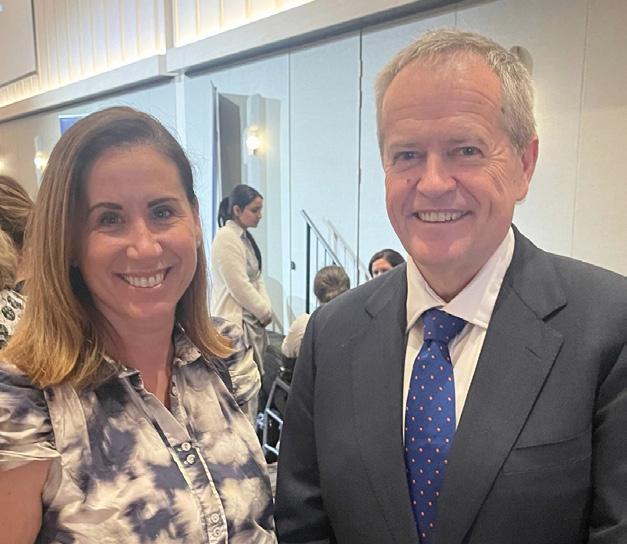
6 otaus.com.au FEATURE
We have noted an inherent synergy between OTA’s priorities and the Government’s reform agenda—specifically in preventative health and person-centred care.
of Government and Stakeholder Relations at OTA, had the opportunity to spend some time with Minister Shorten and conveyed early thoughts from our members on registration and foundational supports.
To help members understand the proposed changes, OTA has developed a dedicated webpage that explains aspects of the final report and the recommendations, as well as OTA’s next steps. It includes a series of frequently asked questions and a video featuring OTA’s CEO, Samantha Hunter. You can access all of this information by scanning the QR code below.
concerns about how allied health professionals, and occupational therapists in particular, are being represented in the Commission’s guidance about pricing of goods and services. OTA also sent a separate letter to both the Minister and the Commission requesting that this issue be resolved. We have received responses from both the Minister and the Commissioner, and OTA will be joining other members of AHPA to meet with the commissioner to discuss the issue further.
sustainability. Ian Yates, Acting Inspector General for Aged Care, spoke about work on the Royal Commission recommendations. Attendees also received updates from the Department of Health and Aged Care and the Aged Care Quality and Safety Commission.
New Aged Care Act and Support at Home Program
You may already know about work currently underway to develop a new Aged Care Act. The project was triggered by recommendations made by the Royal Commission into Aged Care Quality and Safety, and its conclusions that the existing Aged Care Act was no longer fit for purpose. An exposure draft of the Bill was released in December 2023 and was out for consultation until February. OTA attended a briefing and webinars held by the Department of Health and Ageing which provided details of the proposed Bill, including the new regulatory approach model and implementation of a new set of Standards. OTA provided feedback on the draft Bill.
Aged Care
Since the release of the report, OTA has been featured in radio and print media highlighting the issues and opportunities that the review presents for occupational therapists working under the scheme. OTA will continue to advocate for members in 2024 and beyond to influence the government’s response to the review, and ensure occupational therapists are well utilised and acknowledged in any new systems and processes.
NDIS Quality and Safeguards Commission
In the week before Christmas OTA joined other allied health associations to write to the NDIS Quality and Safeguards Commission. We did this under the umbrella of Allied Health Professions Australia (AHPA), to raise the profession’s shared grave
Last quarter representatives from OTA attended several aged care events in Adelaide, including:
National Aged and Community Care Providers Association Conference, which was a valuable opportunity to connect with a range of stakeholders. Key speakers included the Minister for Aged Care, the Shadow Minister, members of the Aged Care Taskforce who spoke on the sustainability of the aged care system, and a panel on the Care and Support Economy.
National Aged Care Alliance, which was an opportunity to hear from speakers about the challenges they are facing in receiving aged care services. Nigel Ray, Deputy Chair of the Aged Care taskforce, spoke about the work being undertaken in aged care funding
The new Aged Care Act includes the introduction of a ‘Support at Home’ program, which will replace the existing Home Care Packages Program, CHSP and Short-Term Restorative Care Programme. OTA met with the Department’s Support at Home Implementation Team, together with members of the AHPA Aged Care Working Group, to discuss the process and principles underpinning the Support at Home program and the vision for the assistive technology and home modifications design. The new Act is expected to be introduced to Parliament sometime in 2024, with further legislative changes to be introduced as the reforms continue.
Mental Health
Several reviews and reforms are underway in the mental health space, arising from the Medicare Taskforce report, the Productivity Commission report on mental health, and the recently released
FEATURE CONNECTIONS AUTUMN 2024 7
Quarterly Update – Member News continued
NDIS Review report and recommendations. There is currently a particular focus on the development of psychosocial and other supports outside the NDIS, or what is being referred to as ‘foundational supports’. These strategies seek to meet the needs of the significant number of people who are not eligible for the NDIS. OTA continues to liaise with the Department of Health and Ageing, OTA’s national reference group, and other members and stakeholders, to communicate key considerations for future psychosocial support service models.
Department of Veterans’ Affairs
Royal Commission into Defence and Veteran Suicide
In late December 2023 OTA made a submission to the Royal Commission into Defence and Veteran Suicide, looking at establishing an entity to monitor the implementation of the Commission’s final recommendations when they are handed down. OTA worked with our DVA National Reference Group to build a submission calling for this entity to focus on wellbeing, and to hold the government to account to ensure veterans can access and receive the services they need. The Royal Commission has been granted an extension; it is anticipated that the final report will be delivered in September 2024.
Other Veterans’ Affairs Activities
In November OTA attended the Health Providers Partnership Forum meeting in Canberra, a forum run by DVA for providers to the scheme. Here we raised issues relevant to our members including low fee rates under the scheme.
OTA also met with the New South Wales (NSW) branch of the Returned and Services League of Australia (RSL) to discuss opportunities for working together to advance issues that are important to veterans, and the health professionals who support them.
Other National Activities
The Australian Health Practitioner Regulation Agency (AHPRA) has developed an ‘interprofessional collaborative practice statement of intent’. The statement seeks to embed interprofessional collaborative practice across its members and ultimately the broader health sector. OTA provided feedback to inform the development of the statement and more recently endorsed the final statement.
State/Territory news
Compensable schemes
Victoria: You may already know that Victoria’s Transport Accident Commission (TAC) recently undertook a review of their accreditation system for occupational therapists. OTA provided a submission informed by feedback from 89 OTA members. Our submission advocated for a simple and fair credentialling process, increased transparency and communication, equitable access to the Above Rate Service Agreement (ARSA), and a revaluation of hourly rates to ensure OTs are compensated fairly.
Queensland: WorkCover QLD recently conducted an independent review of the state’s compensation scheme. OTA attended several stakeholder roundtable meetings and provided feedback to help inform the Government’s response to the independent review’s recommendations.
Western Australia: WorkCover WA is currently taking steps to modernise the state’s workers compensation laws. OTA provided a submission in response to some key proposals which included changes to allied health fees. Our submission rejected proposals that would result in lower fees for travel, report writing and extended consultations, and advocated for the recognition of mental health occupational therapists.
Certificates of capacity: OTA has been advocating to change legislation to enable occupational therapists to issue certificates of capacity under various compensation schemes. To date OTA representatives have met with schemes in Victoria, the Australian Capital Territory and South Australia to further discuss this issue.
Inclusive education in NSW
In November 2023, OTA urged the Government to centralise the employment of occupational therapists in schools, to support inclusive learning for all school children. We did this by writing to the NSW Deputy Premier and Minister for Education and Early Learning, Prue Car, requesting a re-evaluation and restructure of the arrangements that support the use of specialist allied health services in schools. OTA also included this recommendation about occupational therapists in schools in a submission which informed the NSW Legislative Council’s inquiry into children and young people with disability in NSW educational settings.
Funding of community and public healthcare in NSW
OTA provided a submission to inform an inquiry into the funding of community and public healthcare in NSW. OTA highlighted the key barriers to engaging and retaining occupational therapists, including insufficient remuneration and lack of supervision. We also emphasised the need to implement strategies that retain occupational therapists, to ensure that burnout and exit from the profession is addressed and to better enable consumers to access vital services. Our recommendations for change include investigating alternative clinical supervision models, investment in disciplinespecific roles, and more flexible working arrangements for occupational therapists.
8 otaus.com.au FEATURE
MELBOURNE CONVENTION AND EXHIBITION CENTRE
28-29 NOVEMBER 2024
ABSTRACT
Mental Health Forum Call for Abstracts
We welcome submissions from all OTs, allied health professionals and others working in mental health.
What is MHF2024?
The OT Mental Health Forum is a national biennial event, attended by hundreds of occupational therapists working across every area of mental health practice in Australia.
Why present at MHF2024?
> Showcase your project / findings / activity to your OT colleagues
> Improve your presentation and communication skills
> Get feedback or bring fresh ideas to your work
> Impress potential employers by showing you’re engaged in your field
> Grow your network, leadership and influence in the OT community.
Types of presentations
> Oral presentations.
> ePoster display.
> Occupation stations.
NEW TO 2024
> Workshops: 60-90 minute workshop-style presentations on key topics of research, program/strategy implementation or innovation in OT.
Abstract mentoring program
If you’re a little nervous about submitting your abstract, please reach out to us. Our abstract mentoring program will help you organise your thoughts clearly and concisely, to get it right before you submit to our review process.
FIND OUT MORE AND SUBMIT TODAY!
OT MENTAL HEALTH FORUM EMPOWERING
TRANSFORMING LIVES
www.otausevents.com.au/mentalhealthforum2024/call-for-abstract
MINDS
EXTENDED TO 19 MAY 2024
MENTORING PROGRAM AVAILABLE
My Burnout Story
Nicolle de la Perrelle
In 2023, I celebrated 20 years of being an occupational therapist. However, only a couple of years before that I was considering leaving the profession that I loved. In 2017, I had moved into working in public health following the birth of my son as I was concerned about work and mumlife balance in the role I had in the private sector. Public health was something I deeply believed in, and I was proud to contribute as an OT Senior in a number of different roles and then to step up into an acting OT manager role… right as the COVID-19 pandemic started. I’m sure it comes as no surprise that this was a challenging time and after a year, I left this role to return to a purely clinical role in a different area of public health. I thought a return to client work in my preferred rehabilitation settings would resolve my feelings of dissatisfaction, exhaustion and believing that I was a terrible leader. At least with clients, I hoped I would feel inspired and could contribute my clinical skills to help maximise recovery and independence.
Unfortunately, it didn’t take long before any optimism about my new job wore away. I felt frustrated by the scope of OT in the rehabilitation setting and frequently needing to justify our role and recommendations with other allied health professionals and the medical team. At a personal level, I felt tired, flat and unmotivated. I was struggling to complete parts of the role that felt overly complex or bureaucratic. I would procrastinate with some tasks and then stay back extremely late to finish tasks, feeling guilty for my inefficiencies and feeling bad for not being a better therapist. I started to become cynical and frequently found myself reviewing

quickly found myself struggling again. It felt difficult to learn new systems and processes and I still felt perpetually exhausted. I was frequently frustrated by constant changes, administration and significant demands on my time. I felt like an imposter because I was teaching about OT and doubting whether I even still believed in OT. Even the satisfaction of teaching students wore off and I worried I wasn’t performing my role well. I started to question whether I should leave the profession and go work in a bookshop!
A light bulb moment
During COVID-19, I had started to seek some personal support including participating in art therapy. I found this helpful to unpack my muddled thoughts and give me clarity, insight and direction. At one of my art therapy sessions, while I was questioning my abilities and wondering if I would ever find a suitable work role, it was the art therapist who tentatively raised the question of whether I was potentially burnt out.
referrals for OT and doubting whether there was any need for OT or whether we would really make a difference. We were still dealing with COVID-19 challenges and significant staffing challenges in a period of extremely high demand, which often meant changes to service delivery, further impacting my mood and morale at work.
Eventually, I again chose to leave, thinking maybe I just needed to leave client work and the public health system altogether. I moved into a role for a university and felt excited about training and teaching the next generation of therapists and helping allied health practitioners grow their skills through our Masters program. Except I
Burnout. I’d heard of burnout before of course but had probably only associated it with very old, bitter therapists who had stayed in the one role for 40 years! I didn’t think it would happen to me – a passionate OT, who had always felt like my work was a vocation more than just a job. I didn’t really know a lot about burnout – but if it was the feeling of wanting to hide at home under my blankets and never work again, then maybe I was burnt out! I subsequently went on a journey of reading everything I could lay my hands on about burnout. The more I learnt about it, the more it resonated with what I had been experiencing. And the more I learnt about it, the more I needed to know what could be done to help with burnout.
FEATURE 10 otaus.com.au
Figure 1: OTs might be problem solving ninjas but we’re not actually superheroes. Self-care is important too!
Burnout
So, what is burnout? Burnout is described by the World Health Organisation as a syndrome characterised by exhaustion, feelings of distance, negativity or cynicism related to one’s job and reduced professional efficacy, i.e., a decreased sense of accomplishment. Other symptoms of burnout can include irritability, sleep disturbance, lack of motivation, cognitive issues, emotional lability, anxiety, withdrawal, indifference and reduced performance. Burnout is considered to be distinct from depression and may relate to lacking resources, including internal resources and/or job resources, to cope with the demands within a workplace or caregiving role. While I was surprised to find myself fitting in the category of being burnt out, it’s actually common in ‘helping professions’, including occupational therapy.
Looking at burnout through an OT lens indicates there are person, occupation and environmental factors that contribute to burnout. Personal factors that relate to a risk for burnout include:
• Being 30 years old or under (also common in millennials)
• Being female
• Having a higher education
• High levels of dedication and responsibility
• Perfectionistic tendencies (considered to be common in OTs).
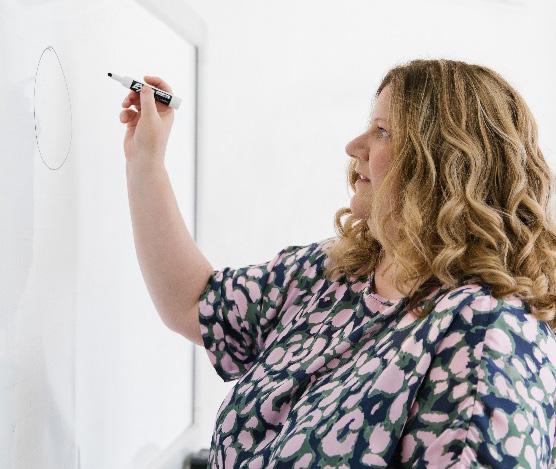
Burnout. I didn’t think it would happen to me – a passionate OT, who had always felt like my work was a vocation more than just a job.
You can see why this can be such an issue for OTs given the close match between these characteristics and the profile of our profession!
Occupation and environmental factors are more complex to separate, but factors that contribute to burnout for OTs include:
• High workloads
• Short staffing
• Time pressures relating to administration demands
• Lack of autonomy
• Role conflicts
• Challenging and confronting client work (may contribute to compassion fatigue)
• Lack of respect and poor recognition of the value of OT
• Mismatch in values between individuals and organisations.
While my burnout may have related to my experiences in public health, evidence from the NDIS Workforce Retention Survey indicates that having workload above capacity, experiencing health and safety risks, personally confronting work and administration and red tape are risks for burnout and decreased job engagement. No doubt media commentary, which can denigrate the value and benefit of occupational therapy, may also contribute to burnout risk in the NDIS OT workforce. Given ongoing workforce shortages and specific pressures and demands on OTs in many workplaces, burnout is a real risk for many OTs, which can lead to significant physical and mental health challenges for individuals.
What can be done?
Research around management and prevention of burnout supports a range
of strategies. This includes addressing the causal factors of burnout at an organisational level and emphasising that burnout is not the fault of individual clinicians. OTs need to be valued and supported to have autonomy, and flexibility to do work they personally find valuable and meaningful, including sufficiently stimulating direct client work. Work roles need to be well supported with supervision and/or mentoring and there needs to be adequate reward and recognition within the organisation and in the community. At an individual level, there has been shown to be benefit in strategies directed at managing the impact of stress on the body, creative expression through art therapy, cognitive strategies such as mindfulness, as well as rest and rest breaks.
From a personal perspective, I found I needed to make some job changes to increase my autonomy, flexibility and meaningful work engagement. I did this by balancing my university work with being a sole trader with a small client load and providing mentoring for other therapists. I continue to engage in art therapy, I receive my own mentoring, and I regularly connect with other OTs for support through in-person coffee catch ups and online groups like The Becoming Collective. I have created space in my life for slowing down and engaging in self-care. I’m still a recovering perfectionist and people-pleaser but I’ve definitely found my OT mojo again!
Occupational therapy and mental health
If you or your clients have experienced burnout, our Mental Health Forum 2024 will offer the opportunity to:
FEATURE CONNECTIONS AUTUMN 2024 11
Figure 2: My OT mojo includes client work, teaching and mentoring.
My Burnout Story – continued
• Learn about mental health challenges affecting OTs and their clients
• Gain skills and tools to effectively support mental health
• Connect with your OT peers in a safe and nurturing space.
Our call for abstracts closes in May and registrations open mid-year. Visit the Mental Health Forum website to submit an abstract or register your interest in attending: otausevents.com.au/ mentalhealthforum2024

Pursue a career in youth mental health
Apply to be a mental health practitioner in secondary schools
These positions offer:
• meaningful work
• job security and flexibility
• work/life balance, with paid school holidays
• access to a range of professional supports
• an opportunity to improve outcomes for students and schools.
About the Author
Nicole de la Perrelle is an experienced occupational therapist working in her own private practice, Encourage OT, and for Flinders University in the Master of Clinical Rehabilitation program. She is passionate about supporting allied health professionals to deliver the best therapy they can, confidently and without burning out.
References
References for this article can be viewed online – scan the QR code:
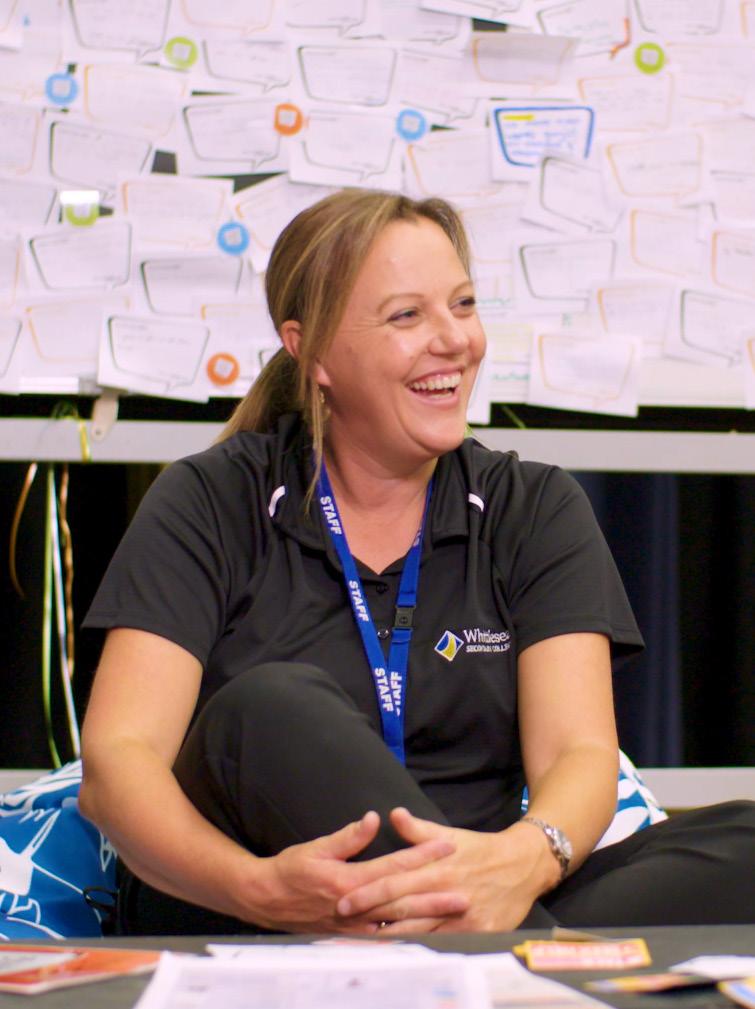
FEATURE
Figure 3: Making time for coffee with other OTs was a really important part of managing my burnout.
Find out more: vic.gov.au Mental health practitioners
WFOT Update
Associate Professor Emma George (1st Alternate Delegate)
WFOT began 2024 by welcoming four new members. Botswana Occupational Therapy Association and the Croatian Association of Occupational Therapists (Hrvatska udruga radnih terapeuta) join as full members of the Federation, and the Association of Nepal Occupational Therapists and Bhutan Association of Occupational Therapists are accepted as new associate members.
This brings the total membership of the World Federation of Occupational Therapists to 109 occupational therapy organisations, representing 633,000 occupational therapists internationally. As a founding member of the WFOT in 1952, Occupational Therapy Australia is proud of the growth of the profession around the world.
WFOT exists to be a global voice for occupational therapy, to set the standard for education and promote excellence in research and practice. The WFOT Council meet every two years and in 2024, Occupational Therapy Australia will be represented by delegate Adam Lo at the Council meeting in Bermuda. Locations for meetings coincide with the WFOT Congress every four years or are voted on by the council members. At the time of writing, Adam is preparing to make the long journey to Bermuda in February and to participate in a week of Council, discuss relevant issues for the profession, and vote on upcoming decisions.
Council meetings provide an opportunity to strengthen international collaboration, debate issues related to governance and education, share resources, and plan for the ongoing development of the profession.
WFOT continues to work with international partners – WHO amongst others – as
they seek to respond to the high level of international conflict and unrest across the globe. WFOT advocates for humanitarian aid and access to health systems for all vulnerable populations around the world. In a public statement (November 2023), WFOT explained that humanitarian aid provides essential services and supplies as essential to saving lives. The WFOT abhors and does not condone actions intended to interfere with the provision of aid and services wherever these take place. Adherence to international laws that enable access and safety for humanitarian response in times of conflict and disaster are essential. The full WFOT statement is available online – scan the QR code:
WFOT has invested in training resources for OTs about Working with Displaced Persons, Disaster Management, and Humanitarian Response. The WFOT works with member organisations to coordinate actions that respond to crises and disasters. A guide on the DOs and DON’Ts for rehabilitation professionals is freely available through WFOT membership. This guide outlines questions to consider before departing for crises areas, working in disaster zones, and returning home. The guide can be accessed by scanning the QR code:
One example of occupational therapist involvement in response to disaster comes from Haiti, in response to the 2021, 7.2 earthquake that killed over 2,000 people, injured 12,00 and left 700,000 people in a state of emergency. Students and rehabilitation professionals (occupational therapy and physiotherapy) collaborated to fundraise online and deployed three teams in different regions affected by the earthquake. Within three days, the teams had completed visits and assessments of the needs of people within three shelters.
A delegation of 30 students and 8 professionals were then able to purchase and distribute necessities. Key outcomes included the distribution of more than 1000 hygiene kits, 500 food kits and 250 medical kits, early rehabilitation for over 300 people, specific assessment for 80 people with disabilities, distribution of clothes to more than 50 children, and technical aids and medical supplies to four hospitals. The project is described in detail as an Innovative Change Agency Narrative on the WFOT website. We encourage you to access your WFOT membership which is complimentary to Occupational Therapy Australia members and explore the many professional resources available.

Turning our attention closer to home, 2024 will be a big year for the Asia Pacific Region. We look forward to the 8th Asia Pacific Occupational Therapy Congress from November 6-9, in Sapporo, Japan. The theme of the congress is Empowering Collaborative Community: Sustainable and Evidence-Based Occupational Therapy. This congress is held every four years and registrations are now open!

WFOT REPORT CONNECTIONS AUTUMN 2024 13
The Value of Experiential Learning and Lived Experience Within OT Training Perspectives from a teacher and a student
Egan Magee and Sanetta H.J. du Toit
Introduction: the challenge for therapists
Occupational therapy is distinguished from other professions by a client-centred focus that facilitates change in line with what is meaningful for an individual. Therefore, authentic teaching and trustworthy research stems from a holistic view of how disability and illness interact with each person’s context. As no one person lives in a vacuum, the relationships between client and world, and indeed, therapist and client, exist within social contexts that cannot be divorced from discrimination, power and systems of oppression. For therapists then, the challenge lies in how we meet someone in their individual context when their identities and experiences lie outside our own.
Why experiential learning?
While case studies, videos and other classic approaches give students an opportunity to unpack theory, experiential learning has been shown to increase student readiness for placement at real world sites (Brand, 2023; Larson, 2016). These exercises, such as simulation labs and other immersive exercises, provide a controlled and ethical way for students to experience how theoretical concepts fit with individuals of multiple identities and marginalisations. For example: for students to understand the value of contextual assessments, such as the Residential Environmental Impact Scale (Fisher, 2014), they must be immersed in the reality of what these living environments look and feel like for both practitioner and the older adult/resident.

Embodied approaches
Caroma Age Lab* provided an opportunity for occupational therapy students enrolled in the Participation and Ageing module at The University of Sydney to be immersed in physical aspects of age-related disability. Students were provided with simulation suits and other props designed to replicate back and knee pain, hand tremors and altered hearing and vision. Led by Dr Adeline Chua, lead Caroma Lab Facilitator, students navigated bathrooms and kitchens designed to optimize independence in day-to-day activities. As each student could personally feel the impact of the suit, the exercise worked to emphasise the unique ways ageing occurs individually, reinforcing the need to match interventions to the person without making any assumptions.
This unique experience offered students insight into the physicality of age-related disability such as how a tremor disrupts
using a bathroom sink. This is shown in the word cloud reflecting student experiences. It does not, however, provide an understanding of the relationship between bodily experience, complex marginalisation, social invisibility on an everyday level, and so on.
*See Caroma Age Lab online – scan the QR code:
Diversity versus representation
The term diversity has been adopted widely as shorthand to describe moving away from homogenous white, western, heteronormative perspectives. However, the term diversity is seen as fraught by many marginalised people. This is
14 otaus.com.au FEATURE

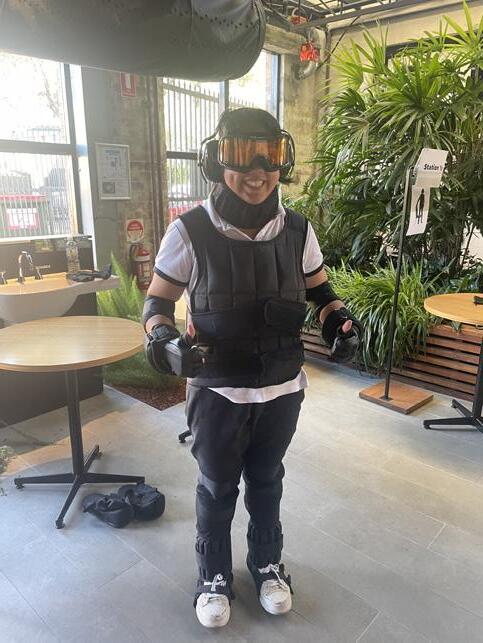
because it positions the speaker from the position of the dominant looking to “diversify” the norm, rather than acknowledging a complexity of living experience. Although we hold shared experience across some domains of life, we are not able to be discretely packaged into fixed categories such as “marginalised” (Trentham et al., 2006).
Often attempts to increase “diversity” in occupational therapy education involve siloing content focusing on clinical outcomes of a specified group within a distinct module. On the surface this seems understandable – focusing time and attention to specific topics. This, however, can serve to do the opposite by implying that people are defined by one main static identity, and neglecting exploration of structural conditions informing the client experience. Furthermore, this can widen biomedical prejudice by creating a hierarchy of importance with clinical skills at the top and psychosocial grounding as an “extra” or “add on”.
Using intersectional complexity
One antidote is to consciously weave intersectional complexity throughout a course. All modules should engage in true representation via a mix of peer reviewed research, experiential learning and, most importantly, inviting the voices of those with lived experience into the room. The need is not for occupational therapy students to be experts on all lived experiences. Rather, it is
to hold skills of respectful curiosity, reflective practice and adaptive communication styles, to enable transcultural engagement rather than focus on literacy of a single group.
“Person first” is a core principle of occupational therapy, guiding our models of practice. This though, begs the question of who we imagine when we say “person”. When we gather information from clients regarding their context, we are only able to receive this information within the parameters of our preconceived biases and existing knowledge. We cannot visualise truly client-centred intervention strategies for a population of people if their identities do not meaningfully live in our consciousness.
Student, teacher, therapist, student
“Nothing about us without us” (Charlton, 2000) has been a rallying cry from the disability justice movement for decades. This simple phrase demands that those who are discussed, researched, institutionalised, medicalised, stereotyped and marginalised be consulted and recognised for the expertise they have of their experience. Who more appropriate, then, to be welcomed into the occupational therapy profession than those living with complex health, disability and multiple marginalisations?
The need for intersectional critical analysis and representation within occupational therapy training programs is not only to improve readiness of new grads. It serves
to signpost that students from varied life experiences are not just allowed to enter but are assets to the profession. At the same time, applying this new standard of literacy to academic teaching staff realigns the profession to see peers at the forefront of knowledge transfer.
References
References for this article are available online – scan the QR code:
About the Authors

Egan Magee lives, works and studies on Gadigal Wangal Land. He is completing his Master of Occupational Therapy at The Sydney University with an undergraduate degree in Medical Science. Egan works in transgender health and holds social and disability justice central to his practice. Contact information: Kmag8757@ uni.sydney.edu.au

Sanetta H.J. du Toit is an international occupational therapy researcher and practitioner with an established reputation for innovation in aged care with minority groups. She is a senior research fellow with the University of Free State (RSA), a senior fellow with the UK Higher Education Academy and previously held clinical positions in the UK, USA and RSA. Her current roles at The University of Sydney, as Discipline of Occupational Therapy Student Liaison Academic for International Students and co-chairing the University’s Mosaic Network, reflect her active leadership in promoting diversity and inclusion. Contact information: sanet. dutoit@sydney.edu.au
FEATURE CONNECTIONS AUTUMN 2024 15
Dr Chua orientating the occupational therapy students for their Age Lab session
All geared up!
OTA’s New Strategic Plan
Foreword
Occupational Therapy Australia (OTA) is a national, not-for-profit, member-based association leading workforce development and support, while advocating for better health and wellbeing outcomes for our members, consumers, and clients, supported by the occupational therapy profession.
The development of OTA’s strategic plan has been conducted in the context of emerging from the immediacy of the COVID 19 pandemic, a rapidly changing local and global landscape and by attempting to understand both the real and anticipated ramifications and opportunities that face both the profession and the wider health and community context in which we seek, find, experience and enjoy occupation.
Our future strategy and approach have been developed in close collaboration with our members and a wide range of friends, supporters, partners and stakeholders. Through deep listening and courageous conversations, we have reflected on our history as a profession and an association, and honour past achievements as we pave the way for a future that is responsive to the progress and prominence of occupational therapy as a leading and growing allied health profession.
With the tenets of occupational therapy at the heart of our association we commit to strategic decision making that respects the principles of our practice and ensures that we operate in a paradigm of recognised sovereignty, inclusivity, accessibility and diversity.
OUR PURPOSE: PROTECTING AND PROGRESSING
16 otaus.com.au FEATURE
IN AUSTRALIA
Leadership Statement
As a national membership association and peak body for occupational therapy, OTA commits to our values of Pride, Progress, Empowerment and Connection. We strive for excellence, increased collaboration and inclusion and forecast a future where occupational therapy continues to make a profound impact on the wellbeing of individuals and communities across Australia. Our leadership will be demonstrated by walking alongside in connection and collaboration with others and considering our impact on the people and places we share our future with.
Fundamental to our shared future is our Journey of Understanding embedding a culture of respect and recognition of Aboriginal and Torres Strait Islander people and their deep connection to culture and Country. As we continually develop deep mutual respect and strengthened relationships with First People’s ways of knowing and doing, we aspire to contribute to a shared and reconciled journey towards a just and equitable future. We recognise the importance of intentionally establishing sovereign relationships with Aboriginal and Torres Strait Islander individuals, communities and peak bodies and seek to hear their voices in a shared future.
We believe that our community is richer through embracing diversity and inclusion and that lived experience is a powerful source of knowledge and wisdom. Each person’s unique journey and perspective offer valuable insights helping us better understand and address complex issues. We commit to listening to and respecting the lived experiences of individuals and understand more effective outcomes are achieved through listening, learning and acting in unity.
We respect the rich history of the profession and lead toward an equitable future where occupational therapy further enhances and empowers individuals and communities.
FEATURE CONNECTIONS AUTUMN 2024 17 PROGRESSING OCCUPATIONAL
THERAPY
Tina Champagne is coming this June!
Who is Tina Champagne?
Dr Tina Champagne is a world-renowned occupational therapist and sensory modulation expert. She has received many awards for her work including the 2023 Award of Merit, the highest honour from the American Occupational Therapy Association. We are thrilled to announce that Tina will be embarking on a multistop tour across Australia in June 2024.
What is the Tina Champagne Tour?
Beginning in Melbourne, Tina Champagne will then journey to Perth and Sydney, offering a variety of events tailored for OT clinicians at various levels of experience. She will also be a keynote speaker at the OT Exchange 2024 conference, which takes place in Perth on 13-14 June 2024.
How can I attend?
Due to limited availability and high demand, we strongly encourage you to register as soon as possible to secure your tickets and avoid disappointment. For more information and to register to attend, visit (or scan the QR code):
More
Due to limited availability and high demand, we strongly encourage you to register as soon as possible to secure your tickets and avoid disappointment.
about Tina
Dr. Tina Champagne is the CEO of Cutchins Programs for Children and Families and an international consultant for Champagne Conferences & Consultation. She has specific expertise in the areas of trauma, attachment, sensory and trauma informed approaches, and organisational change.
In 2003, Tina became the first OT to present with the U.S. National Office of Technical Assistance on sensory approaches, trauma informed care and restraint reduction, where her work became part of the Six Core Strategies.
She has authored numerous publications, including two books, numerous book chapters, continuing education and research articles, and she is a reviewer for OT and nursing journals.
Event Dates
Melbourne, Tuesday June 11: Sensory Modulation and Trauma Informed Care Masterclass
Perth, Wednesday June 12: Sensory Modulation and Trauma Informed Care Masterclass
Sydney, Tuesday June 18 to Wednesday June 19: Sensory Modulation, Trauma and Attachment Informed Care Workshop
OUT SOLD OUT
Sydney, Thursday June 20 to Friday June 21: Embedding Sensory Approaches and Trauma Informed Care in Occupation-Based Practice Workshop (train the trainer).

18 otaus.com.au FEATURE
SOLD
Diversity, Equity & Inclusion: How to find blind spots in your OT practice
WorkPlacePLUS
As Australia’s working landscape continues to evolve, compliance requirements for occupational therapists and practice owners are increasing. For example, fostering diversity, equity and inclusion (DEI) is not simply a ‘nice to have’ target – it’s a requirement under the Respect at Work Act.
Quick refresh: What are D, E & I?
Workplace diversity means recognising the variety of differences between your employees and understanding the varied perspectives, approaches and talents these differences bring to your workplace.
Workplace equity means all employees are provided with fair and equal opportunities based on their individual needs. This is sometimes referred to as EEO – equal employment opportunity.
Workplace inclusion means understanding and respecting employees’ differences, so that everyone feels valued in the workplace and can contribute to their full potential.
How to cultivate DEI
To foster DEI in your occupational therapy practice, it’s important to be able to identify unconscious biases in the workplace, challenge them, and learn about fair and equitable work practices.
Everyone has unconscious biases; it’s part of being human. We are biologically hardwired to take mental shortcuts by aligning with the ‘familiar’ and rejecting anything ‘different’.
Unfortunately, in the workplace, unconscious biases can affect individual and collective decision-making and create inequitable work practices, which can ultimately result in unlawful discrimination.

I’m not biased! Am I?
Dozens of biases commonly occur in the workplace. Here’s a snapshot of just a few:
1. The Horn Effect – Happens when you perceive something negative about a person and then cast them in a negative light permanently.
2. The Halo Effect – Happens when you perceive something positive about a person and then cast them in a positive light permanently.
3. The Anchoring Effect – Tendency to anchor onto the first piece of information you receive and base all subsequent judgments or opinions on this.
4. The Ostrich Effect – Only considering the information that matters to you and dismissing other factors.
Can you think of examples of when you have been affected by one or all of these bias effects? We’re all influenced by them at least some of the time.
The good news is we can take steps to minimise our biases. Learning about unconscious biases reminds us to challenge our instincts, which is an important step towards championing diversity, equity and inclusion in the workplace.
Your legal obligations
If you have questions or need more information about your employer and employee obligations under antidiscrimination laws and the Respect at Work Act 2022, it is best to seek professional advice through:
• The Fair Work Ombudsman,
• The Australian Human Rights Commission, or
• An HR consultancy that works closely with the allied health sector such as WorkPlacePLUS.
OTA member benefits
OTA members receive special benefits through WorkPlacePLUS for support with human resources (HR) and Industrial Relations (IR). For more information, contact Anna on (03) 9492 0958 or visit WorkPlacePLUS.com.au (scan the QR code):
CONNECTIONS AUTUMN 2024 19 WORKPLACE RELATIONS
© Getty Images/sturti
Photo:
Allied Health Professionals need NED
Indigo (formerly the Independent Living Centre of Western Australia) has been a trusted local name in assistive technology (AT) for over 40 years.
Indigo is proud to re-launch the new and improved National Equipment Database (NED). NED is Australia’s largest online assistive technology and equipment database. It provides free and impartial information and advice on over 25,000 products and equipment from over 4,000 verified suppliers across Australia. As a registered charity, Indigo has no vested interest in any supplier or brand. So you can be sure you’re getting accurate and unbiased advice to help you make the right choice for your clients. Equipment and products listed on NED are carefully vetted by our procurement team for quality, safety, affordability, and compliance with consumer law and standards.
With NED, you can:
• Browse a one-stop-shop with over 25,000 assistive living products and equipment

Receive support and advice from our team of Occupational Therapists and professional staff
“Indigo’s National Equipment Database –NED, is exactly what allied health professionals need to help their clients explore, find, and buy assistive technology, equipment and products.”
Marchant, Occupational Therapist and Indigo Marketplace and eCommerce Manager
• Get access to high quality and relevant suppliers
• Compare and contrast products from different suppliers to assess features and price
• Filter items by brand, price, measurements and more
• Safely click to buy selected items
• Be sure that products are suitable and safe
• Get support and advice from our team of Occupational Therapists and professional staff
Easy Product Assessment for Health Professionals
NED allows you to quickly identify and compare products and equipment for your clients on a single platform. So you can be sure your chosen products will meet your selected criteria. Health Professionals can undertake side-by-side comparisons of similar products from different suppliers which enables easier and more accurate assessment – a feature not available on any other AT website.
Using NED is Quick and Simple
Searching for products and equipment on NED is simple. Browse the catalogue of items and filter by brand, price and important measurements. NED items have up-to-date descriptions, a list of suppliers, and specifications. You or your clients can purchase products securely through NED. You can also contact the supplier direct for information.
NED ensures that clients around Australia can access high quality, safe and affordable assistive living products and equipment from leading suppliers, with audited pricing and proven quality customer service.

NED is NDIS Friendly
NDIS codes are provided against products and equipment to allow filtering by code. Simple and low-cost products and equipment can have a Proforma Invoice generated from NED that can be sent to any third party to enable quick and easy approvals and purchase. Health professionals, AT advisors and support coordinators can also receive and review requests through NED and a payment link can be generated via NED to order equipment or products for direct delivery to your client.
For complex AT, a Request for Quote through NED allows you to connect directly with suppliers. For access to all the products and equipment needed for independent living, browse the full range of items on NED today. askned.com.au
About Indigo
Indigo’s experienced health professionals help people of all ages choose and access equipment, technology and services for their independence and wellbeing.
We offer services including:
• assistive technology (devices and equipment) advice, assessment, prescription and provision
• allied health (occupational therapy, physiotherapy and speech pathology)
• home modifications
• services for schools to participate and learn, and
• professional training.
In addition to managing NED, the nation’s largest assistive devices database, Indigo is the national provider of Australian geat2GO funded under the Commonwealth Home Support Program.
20 otaus.com.au ADVERTORIAL
Sacha
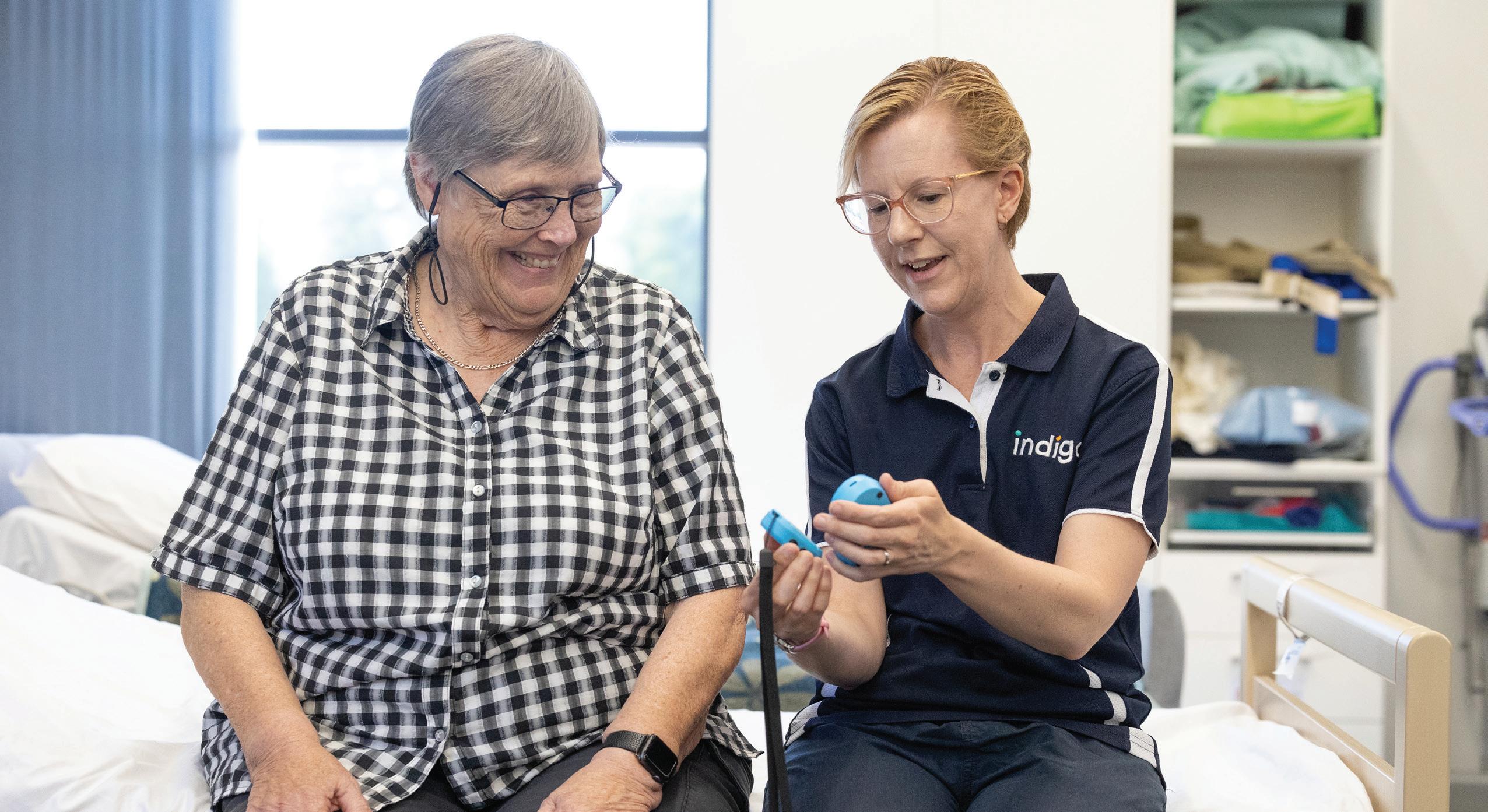
The trusted name in assistive technology for over 40 years, Indigo is proud to bring NED to life. As the largest assistive technology database in Australia, NED is your one-stop-shop for over 25,000 quality products.
With NED, choosing products is easy and you can filter options according to your clients’ needs. You have a range of trusted suppliers to select from to ensure you get the equipment you want.
Proforma invoicing makes purchasing by funding bodies or individuals quick and easy. For more complex items, the 'request for quote' facility connects you directly with suppliers.
With NED, you can:
Browse over 25,000 products and equipment, including helpful information and advice.
Click to buy selected items.
Filter items by brand, price, measurements and more.
Phone line support and advice from our team of Occupational Therapists and professional staff.
And so much more!

Scan the QR code to find out more about how NED works, or browse our database today at askned.com.au askned.com.au Make life a little easier for your clients with ned, our extensive National Equipment Database what you need. has
AOTJ Update
Your Australian Occupational Therapy Journal – Louise Gustafsson
Editorial Board
The editorial board continues to meet six times a year to discuss strategic and operational aspects of the journal. At the end of 2023 we said farewell to Professor Carol McKinstry and Associate Professor Genevieve Pepin who have contributed to the strategic and operational aspects of the journal across many years, most recently as Associate Editors. We would like to thank them for their leadership and contributions to the journal and the Australian occupational therapy profession.
We received many expressions of interest in response to the recent call for new Editorial Board Members – it is always a highly competitive process! I am pleased to announce that the Editorial Board for 2024 is:
Editor-in-Chief –
Prof Louise Gustafsson
Associate Editors –
Prof Angus Buchanan
Assoc Prof Jacki Liddle
Dr Tammy Aplin
Prof Stephen Isbel
Dr Carolyn Murray
Editorial Board Members –
Dr Miia Rahja
Dr Kylie Wales
Dr Kylee Lockwood
Prof Courtenay Harris
Assoc Prof Samantha Ashby
Publisher report
The Australian Occupational Therapy Journal is published by Wiley who deliver an annual report of the journal’s performance. Detail from the publisher’s report for 2022 indicates that the journal was available in over 7000
Our publisher’s report for 2022 indicates that the journal was available in over 7000 institutions worldwide, articles were viewed 544 722 times, and Australia contributed 31% of this usage.
institutions worldwide, articles were viewed 544 722 times, and Australia contributed 31% of this usage. From an author perspective, the acceptance rate for submissions in 2022 was 33% and the median time from submission to first decision was 50 days (26 days if we include papers with an editorial decision to reject without peer review).
I am assured that these figures are consistent with best practice and good indicators for the journal! We will receive the report for 2023 towards the middle of this year and I will share updates with you at that time. Other metrics and data are available on the journal website – access it by scanning the QR code:
Update on practice areas represented in the journal
We have seen an increase in submissions from practice areas that were highlighted as under-represented in the journal when we last surveyed the Occupational Therapy Australia membership. As discussed
in a subsequent editorial, the underrepresentation was not the result of triage processes within the journal and rather due to limited submissions from specific practice areas. It is a great outcome that we now have several papers representative of these practice areas in the review and publication processes of the journal.
Activities for 2024
In 2024 we will engage in a participatory process to explore, reveal, and understand how current journal processes support bias, assumptions, injustices, and prejudices against Aboriginal and Torres Strait Islander Peoples. Please email me at editoraotj@ otaus.com.au if you would like to be involved or receive more information.
Keeping up to date
With the following steps you can ensure that you remain up to date with the latest articles and initiatives from the journal.
1. Sign up for email alerts on the journal home page https://onlinelibrary. wiley.com/journal/14401630
2. Follow us on LinkedIn – Editor, Australian Occupational Therapy Journal. 3. Follow us on X – @AusOTJournal.
22 otaus.com.au AOTJ UPDATE

LIFTING HAS NEVER BEEN EASIER
The Raizer II Lifting Chair is the new and improved truly single-handed solution to lifting someone who has fallen with ease and dignity
Faster, stronger, and more stable than traditional inflatable lifting cushions, the Raizer II Lifting Chair is an ideal solution for transferring someone who has fallen to a sitting or standing position.

Easy to Assemble
4 identical legs and 2 identical back rests ensure correct assembly every time.
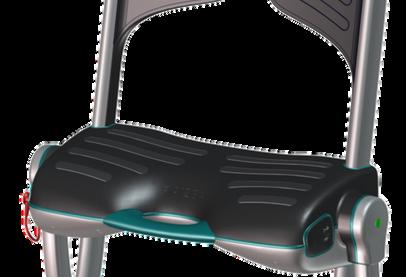
Cleaning Friendly
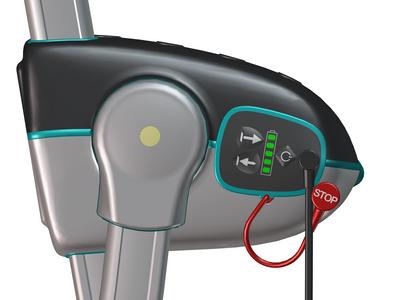
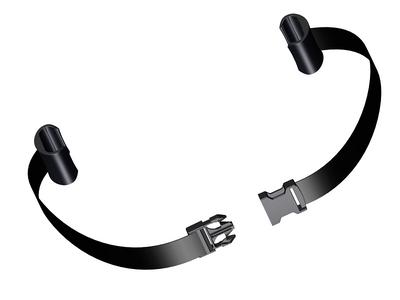

Sleek surfaces make it possible to disinfect more easily
Remote Control
Purpose built storage cavity for remote, moulded to the side of seat casing Emergency stop button is more intuitive
Adjustable Seatbelt
Independently adjustable seatbelt placed on the back rest ensures improved upper body stability when lifting fallen person
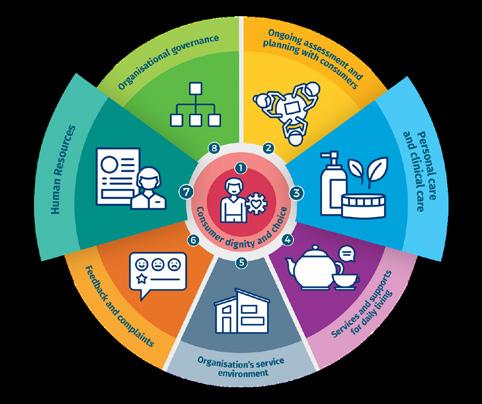

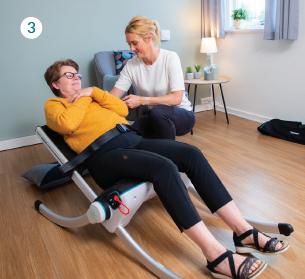





SCAN TO BOOK A FREE TRIAL
JD Healthcare Group seeks out the best and most innovative medical devices available from around the world to ensure maximum staff safety and optimum patient outcomes


1300 791 404 | sales@jdhealthcare.com.au | www.jdhealthcare.com.au
Business Insurance 101:
Important things you need to know
In our summer edition we looked at Personal Accident Insurance and why it’s so important. But what if you’re running a business? Here we offer an overview of key policy and cover types for your business, plus best practices for choosing the right policy and making claims.
Business insurance is a purchase you really should make, not necessarily one that you want to. But while a lot can go right while running your own business, it’s also no understatement that a lot can go wrong. Despite your professionalism and expertise, some things are simply out of your control. Theft, a customer injury, property damage or a data breach are just a few things that can occur. So it’s important to have insurance to protect your business from issues such as these that may result in huge costs you need to pay.
Main types of business insurance:
1. Professional Indemnity Insurance
Professional Indemnity (also known as PI insurance) may cover claims made against your business by customers or other third parties alleging that your business has caused them loss or harm while performing your professional services. PI insurance will often cover several costs that may arise from an allegation of professional negligence, including:
• Claim investigation costs
• Legal costs
• Settlements and court orders or judgments associated with claims against your business, and
• Public relations costs, provided they are covered by the policy.
2. Public Liability Insurance
Public Liability insurance typically covers damages you’re legally responsible to pay a third party, for personal injury or
property damage caused if your business has acted negligently. This could include their legal fees and your legal costs incurred in responding to the claim, even if a court decides you’re not liable to the third party.
3.
Product Liability Insurance
Product Liability insurance may help protect against claims of personal injury or property damage that a third party suffers (or claims to have suffered) as a result of your business’s product. Product Liability insurance typically covers legal liability and legal costs that result from a claim. Depending on the policy you take out, Product Liability may also cover incidents that occur at your business premises, as well as incidents at other locations. Public and Product Liability insurance are usually sold as one combined policy.
4.
Cyber Insurance
Cyber insurance may help cover your business’s financial losses if it falls victim to cybercrime. It could help cover a wide range of cyber related risks, and risks relating to information technology infrastructure. A claim under Cyber insurance may cover financial losses your business suffers as a result of a cyber incident (known as first party cover), as well as losses suffered by third parties as a result of the incident (known as third party cover).
5. Business Insurance Pack
Business Insurance Pack (also known as BP or Biz Pack) may help protect your business and its assets against liability and unexpected insured events. BP usually has a variety of sections of cover, so you can select the sections that you need. For example, the sections of cover that are commonly included in a BP policy include:
• Fire and Perils
• Theft
• Glass
• Business Interruption, and
• Public and Products Liability.
6. Personal Accident Insurance
Personal Accident insurance may help protect you as an individual, in the event of accidental injury or sickness that results in you being unable to work. Cover may include weekly benefits; capital benefits and optional weekly business expenses cover to support you if you are injured or sick and are unable to work.
How to choose between insurance policies
With the wide range of providers, brokers and policy types, it’s only normal to feel overwhelmed when deciding which insurance policy to take out. This challenge leads many business owners to settle for the lowest price they can find, without considering the features and coverage of the policy.
Key factors to consider when choosing between policies:
1. Are additional benefits automatically included in the policy or available at an extra cost? For example, unlimited retroactive date, no excess for certain claims and complimentary legal advice.
2. Does the insurance provider offer ‘run-off cover’ for claims-made policies? Professional Indemnity policies are usually a ‘claims-made policy’. This means that they can respond to claims that are made against you and notified to the insurer while the policy is in force (during the policy period). When you leave the profession or retire, claims can still be made against you for services you provided when you were working, so to insure you for your past work, you may require run-off cover.
24 otaus.com.au FEATURE
Aon
3. What is the insurance provider’s claims process like? Making a claim can be stressful, so the last thing you’d need at that point is a lengthy process. It’s wise to choose an insurer that has a dedicated claims team you can contact, together with an online lodgement process.
4. Does your insurance provider or broker have a deep understanding of your industry? Do they stay on top of emerging risks and regularly review their policies to make sure they cover the risks associated with your profession adequately?
5. Can your insurance provider meet your additional needs as your business grows? Even if you already have business insurance, it’s important to make sure your cover stays up to date with your business’s circumstances as you continue to adapt to an ever-changing environment.
6. Would an insurance broker be helpful? An experienced insurance broker may help you arrange a policy that is customised for the common risks of your industry. They may also assist you manage your claim with the insurer so you can get the most out of your cover.
Keeping
your cover up to
date
In an ever-changing environment, making sure your cover is up to date is also important. Fortunately, you can do this in four simple steps:
Step 1: Check the basic details of your policy
Basic details like your insured name and address can be easy to skim over, but if incorrect, can cause more than just unnecessary hassle at claim time. In fact, one of the first things an insurer may look at when a claim is advised is the insured name specified on your policy schedule. If the detail of the insured who the legal action or complaint has been made against are not the same as the insured listed on your policy schedule then your policy may not respond, or at the very least this could hold up the process of assessing the claim and confirming indemnity. The types of errors which are most common include:
• Insuring your trading name instead of your registered entity
• If you have a pty ltd company and forgetting to add the pty ltd onto the insured name
• If you forget to add a registered entity / company altogether.
Step 2: Review your business description and/or insured professional services
With the wide range of providers, brokers and policy types, it’s only normal to feel overwhelmed when deciding which insurance policy to take out. This challenge leads many business owners to settle for the lowest price they can find, without considering the features and coverage of the policy.

Your insurance documents should clearly state all the services your business or practice provides. If you are currently providing services which are not listed on your insurance policy, or conducting activities which are outside the scope of your qualifications, you may not be insured in the event of a claim. This is particularly important if you’ve taken on new staff members or independent contractors who provide additional service(s) which are not noted on your insurance policy.

FEATURE CONNECTIONS AUTUMN 2024 25
Tunstall Gem5 Personal alarm and smartwatch, with fall detection and GPS technology tunstallhealthcare.com.au/tunstall-gem5 Keeping your clients safe in the community
Step 3: Assess the limits and sum insured
In the same way that your work may change over the years, when it comes to insuring your business assets, such as your office equipment, your sum insured should be reviewed to check you have insured for the new replacement value (where required). If you don’t insure for the new replacement value and the underinsurance clause is applied, it may cause you significant financial hardship. You should also be aware of any obligations you have, such as regulatory requirements or even a contract you may have signed that requires you to maintain specific sums insured. Learn more about underinsurance here.
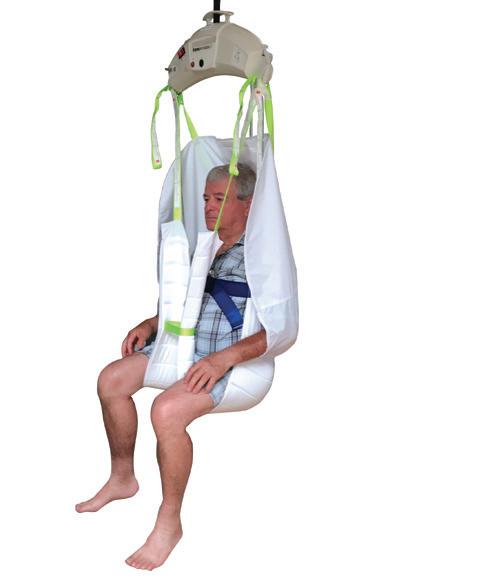


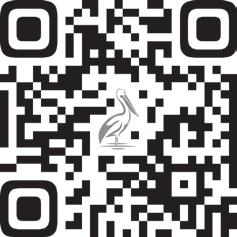
Step 4: Check the coverage details of your Professional Indemnity (PI) Insurance
PI has several features which should be understood to make sure you have adequate protection. Some of these features are outlined in this article, but it doesn’t stop there. Other areas of coverage you may need to look into include whether your policy covers you working out of various locations and whether work performed by contractors is covered.
Making
insurance claims and what to expect
Making an insurance claim can feel stressful, but it doesn’t need to be. It can be useful to think about the process in three steps.
1. Contact your broker or insurer
The first and most obvious step to take when you need to make a claim is to contact your insurance broker. Before doing this, have as much detail as possible ready to provide. You might like to write down a summary of ‘who/what/when/where/why/how’ so that it’s easier to answer any questions. Then it’s a good idea to call your broker to find out what they need from you and how they require you to proceed. It’s also best practice to notify them of the incident, claim or complaint by email, so that you’re establishing a record of the notification.
Another point to note is that if you hold Professional Indemnity insurance, you may be required to notify your broker as soon as practical and before your policy renews or expires, of a ‘circumstance which may give









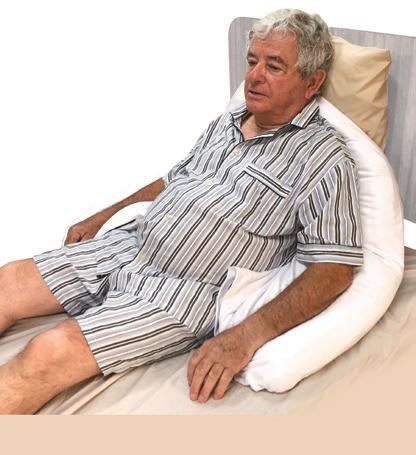




26 otaus.com.au FEATURE
Thermoregulating Sheets, Pillow Cases, Calming Sheets, and Bed Wedges
rise to a claim’. You should also provide any documents, demands, and correspondence that you have received, as the insurer needs to review the details and may need other documents from you as well.
2. Gather your evidence and paperwork
Once you’ve contacted your broker and outlined the full situation, you’ll most likely be asked to provide relevant documentation to support your claim. Again, the type of documentation you’ll need to provide will depend on the type of insurance policy you’re claiming on, so always check with your insurer or broker to confirm what they need.
3. Pay your excess
Many insurance policies will have an excess, but the point at which they need to be paid may vary. Under some policies, the excess may be payable upfront when the claim is submitted, or at the end of any repairs. For other policies, the excess needs to be paid towards the legal and defence costs either when the claim is accepted by the insurer or after the claim has been settled (i.e. cost inclusive excess vs. cost exclusive excess).
Making an insurance claim can feel stressful, but it doesn’t need to be. It can be useful to think about the process in three steps.
Insurance offer for OTA members
Aon is the preferred insurance broker to Occupational Therapy Australia. AON has worked with OTA and insurers to create insurance cover tailored for the risks commonly found in the practice of occupational therapy. Some of the benefits they offer include:
• 15 months of cover for the price of 12 for new Aon clients
• Special OTA member rates.
Visit the OTA website for more information about Aon insurance and other member benefits. otaus.com.au/membership/ member-benefits
© 2024 Aon Risk Services Australia Limited (ABN 17 000 434 720) AFSL 241141 (Aon). The information contained in this communication is general in nature and should not be relied on as advice (personal or otherwise) because your personal needs, objectives and financial situation have not been considered. Before deciding whether a particular product is right for you, please consider your personal circumstances, as well as the relevant Product Disclosure Statement (if applicable), Target Market Determination and full policy terms and conditions available from Aon on request. All representations in this communication in relation to the insurance products Aon arranges are subject to full terms and conditions of the relevant policy. Please contact Aon if you have any queries.
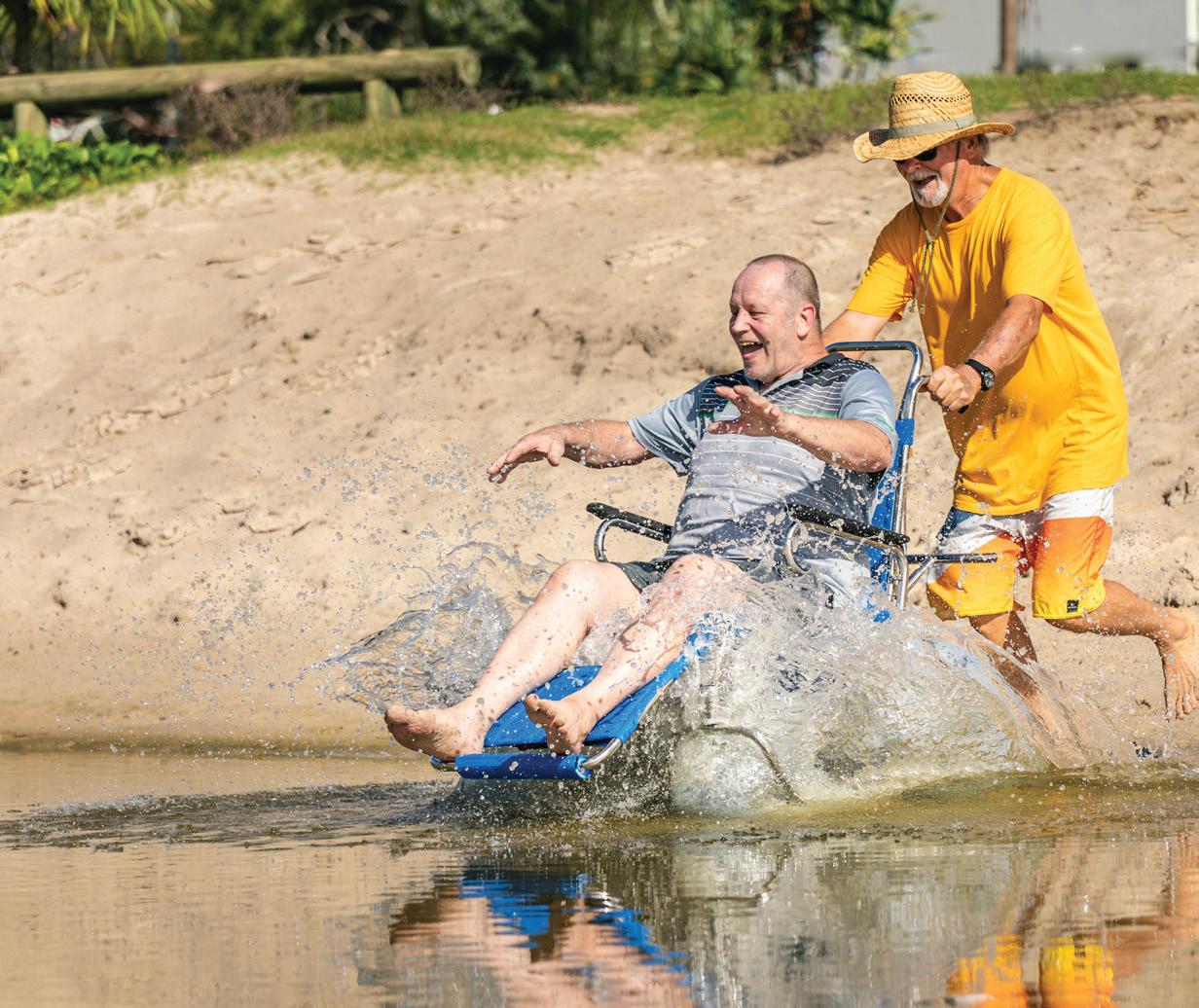

FEATURE CONNECTIONS AUTUMN 2024 27
Call for a product trial today! 0417 613566 View our all-terrain mobility products at: • 316 STAINLESS STEEL • FACILITATES MEDICAL SUPPORTS • TRANSPORTABLE ACCESS ALL-TERRAINS!!
What’s the link between “pushups” and wheelchair transfers? How to limit unnecessary transfers?
What’s the link between push-ups and transfers?
A reasonably active wheelchair user would perform approximately 10 to 15 transfers per day, increasing to 30 to 40 transfers for very active people. It is difficult for ablebodied people to appreciate the everyday stress on the shoulders, which bears the weight during transfers. Using “pushups” as an equivalent, this would equate to 50 to 75 push-ups per day (fig. 1).1
“My shoulder just screams at me every time I load too much and this happens with every transfer. But if I try to do it in another way I will just fall over so I have to deal with it”
(WU3 from Barbaresch 2020)
Are all transfers of the same value to wheelchair users?
Daily transfers, such as transferring from the bed, car within the bathroom, are essential for people with spinal cord injury to remain independent. Wheelchair users emphasise the value of transfers in the context of family life, work and ability to travel.2
“I get on the couch in the play room to read and play with my little boy”
(WU5 from Barbaresch 2020)
“I transfer onto a perching stool when I teach to my student because when I was teaching from my wheelchair my students couldn’t see me or hear me and this was starting to affect my work”
(WU11 from Barbaresch 2020)
“I drive everywhere, I am in and out of the car constantly, so car transfers are very important to me”
(WU4 from Barbaresch 2020)
How can you help wheelchair users limit unnecessary transfers?
Whilst daily transfers are important to enable wheelchair users to maintain
independence, transfers give risk to greater stress on the shoulders. The impact of transfers can be two to three-folds greater than during propulsion, with the shoulder taking on the weight-bearing locomotor function. With age, there is a tendency to develop degenerative pathologies.1
What if you could help limit the number of unnecessary transfers, such as transferring to the toilet to empty the bladder? One in three of the daily transfers are associated with bladder emptying in the toilet.3 That’s approximately 3 to 5 transfers, equating to 15 to 25 push-ups for a paraplegic, which doubles for tetraplegic individuals.1
“When I was transferring onto the toilet, my arms gave out.”
(Female, 32 years old with SCI, from Sung 2022)
Furthermore, the bathroom has been reported as the location of greatest risk of falls during transfers.3,4 One in three falls occur when the person is transferring from

28 otaus.com.au
Figure 1. Daily shoulder use wheelchair people, expressed as “push-up” equivalents1
ADVERTORIAL
Did you know: one third of all daily transfers are associated with intermittent catheterisation1
Did you know: one third of all daily transfers are associated with intermittent catheterisation1
Did you know: one third of all daily transfers are associated with intermittent catheterisation1

Wheelchair users perform 15 to 20 manual transfers per day2.
Wheelchair users perform 15 to 20 manual transfers per day2.
Over time, transferring daily can lead to repetitive strains to the shoulders and wrists. In fact, 20% of spinal cord injured patients reported that upper extremity pain was acute in their first year of injury3 .
Wheelchair users perform 15 to 20 manual transfers per day2.
Over time, transferring daily can lead to repetitive strains to the shoulders and wrists. In fact, 20% of spinal cord injured patients reported that upper extremity pain was acute in their first year of injury3
SpeediCath® Flex Set
Over time, transferring daily can lead to repetitive strains to the shoulders and wrists. In fact, 20% of spinal cord injured patients reported that upper extremity pain was acute in their first year of injury3
SpeediCath® Flex Set
The SpeediCath Flex Set offers a set solution with an easy-to-handle sleeved catheter that can gently navigate the curves and bends of the urethra.
The SpeediCath Flex Set offers a set solution with an easy-to-handle sleeved catheter that can gently navigate the curves and bends of the urethra.
SpeediCath® Flex Set
Flexible tip
Flexible tip
Gentle insertion and withdrawal through the male urethra.
Gentle insertion and withdrawal through the male urethra.
Flexible tip
Integrated handles
Integrated handles
Gentle insertion and withdrawal through the male urethra.
Easy to control bag while keeping hands and clothes dry.
Easy to control bag while keeping hands and clothes dry.
Integrated handles
Easy to control bag while keeping hands and clothes dry.

The SpeediCath Flex Set offers a set solution with an easy-to-handle sleeved catheter that can gently navigate the curves and bends of the urethra.
Dry-touch sleeve
Dry-touch sleeve
Ensures a no-touch, hygienic insertion.
Ensures a no-touch, hygienic insertion.
SpeediCath® Flex Set (Male –
SpeediCath® Flex Set (Male – 33cm / 1000ml)* - 30 units/box
Continuing your Continence Care
Continuing your Continence Care
Continuing your Continence Care
Easy opening
Dry-touch sleeve
Easy opening
Clean tear for easy open and easy pouring.
Ensures a no-touch, hygienic insertion.
Clean tear for easy open and easy pouring.
Easy opening
Integrated urine bag
Integrated urine bag
An all-in-one solution ensures you can catheterise at home or away.
Clean tear for easy open and easy pouring.
An all-in-one solution ensures you can catheterise at home or away.
Integrated urine bag
An all-in-one solution ensures you can catheterise at home or away.
At Coloplast, we know your patients may find that managing their bladder and bowel health can distract them from living their life to the fullest. That’s why we challenged ourselves to set new expectations on what better could look like - making millions of lives easier by doing so and supporting them to live their lives to the fullest.
At Coloplast, we know your patients may find that managing their bladder and bowel health can distract them from living their life to the fullest. That’s why we challenged ourselves to set new expectations on what better could look like - making millions of lives easier by doing so and supporting them to live their lives to the fullest.
To learn more about Coloplast Care, scan the QR code or call 1800 856 306
To learn more about Coloplast Care, scan the QR code or call 1800 856 306
At Coloplast, we know your patients may find that managing their bladder and bowel health can distract them from living their life to the fullest. That’s why we challenged ourselves to set new expectations on what better could look like - making millions of lives easier by doing so and supporting them to live their lives to the fullest.
Always read the label and follow the directions for use. Prior to use, be sure to read the Instructions for Use for Information regarding Intended Use, Contraindications, Warnings, Precautions, and Instructions.
To learn more about Coloplast Care, scan the QR code or call 1800 856 306
Always read the label and follow the directions for use. Prior to use, be sure to read the Instructions for Use for Information regarding Intended Use, Contraindications, Warnings, Precautions, and Instructions.
Always read the label and follow the directions for use. Prior to use, be sure to read the Instructions for Use for Information regarding Intended Use, Contraindications, Warnings, Precautions, and Instructions.
Coloplast Pty Ltd, PO Box 240, Mount Waverley, VIC 3149 Australia www.coloplast.com.au Coloplast and the Coloplast logo are trademarks of Coloplast A/S. ©2024-01 CON624 Coloplast A/S. All rights reserved. PM-30344
1.
Evidence-based guidelines for best practice in urological health care Catheterisation urethral intermittent in adults, dilatation, urethral intermittent in adults, EUMA, 2013, p,1-96 2.
JS, et al, Effects of a standard transfer exercise program on transfer quality and activities of daily living for transfer-dependant spinal injury patients, J Phys Ther Sci 2017, 29, 478-483 3.
Shoulder pain
its consequences in
spinal cord injured, wheelchair users, Spinal Cord, 2004, 42, 41-46
Vahr S, et al.
You
Samuelsson KAM et al
and
paraplegic
/ 1000ml)* - 30 units/box Single Loop 10Fr 28931 12Fr 28932 14Fr 28934 16Fr 28936
33cm
Coloplast Pty Ltd, PO Box 240, Mount Waverley, VIC 3149 Australia www.coloplast.com.au Coloplast and the Coloplast logo are trademarks of Coloplast A/S. ©2024-01 CON624 Coloplast A/S. All rights reserved. PM-30344 1. Vahr S, et al. Evidence-based guidelines for best practice in urological health care Catheterisation urethral intermittent in adults, dilatation, urethral intermittent in adults, EUMA, 2013, p,1-96 2. You JS, et al, Effects of a standard transfer exercise program on transfer quality and activities of daily living for transfer-dependant spinal injury patients, J Phys Ther Sci 2017, 29, 478-483 3. Samuelsson KAM et al Shoulder pain and its consequences in paraplegic spinal cord injured, wheelchair users, Spinal Cord, 2004, 42, 41-46
Set (Male – 33cm / 1000ml)* - 30 units/box Single Loop 10Fr 28931 12Fr 28932 14Fr 28934 16Fr 28936
SpeediCath® Flex
Coloplast Pty Ltd, PO Box 240, Mount Waverley, VIC 3149 Australia www.coloplast.com.au Coloplast and the Coloplast logo are trademarks of Coloplast A/S. ©2024-01 CON624 Coloplast A/S. All rights reserved. PM-30344 1. Vahr S, et al. Evidence-based guidelines for best practice in urological health care Catheterisation urethral intermittent in adults, dilatation, urethral intermittent in adults, EUMA, 2013, p,1-96 2. You JS, et al, Effects of a standard transfer exercise program on transfer quality and activities of daily living for transfer-dependant spinal injury patients, J Phys Ther Sci 2017, 29, 478-483 3. Samuelsson KAM et al Shoulder pain and its consequences in paraplegic spinal cord injured, wheelchair users, Spinal Cord, 2004, 42, 41-46
Single Loop 10Fr 28931 12Fr 28932 14Fr 28934 16Fr 28936
What’s the link between “push-ups” and wheelchair transfers? How to limit unnecessary transfers? –
wheelchair to use the toilet or shower.3 Avoiding falls during transferring has been found to be one of the primary concerns for the majority of people in wheelchairs, with excessive fear having a negative effect on both confidence and transferring technique.2
Enabling people in wheelchairs to void using intermittent self-catheters is important as intermittent catheterisation remains the gold standard for bladder management for individuals with SCI.5
However, is it always necessary to transfer from the wheelchair to the toilet, considering the shoulder burden and risk of falls? What if you could limit the number of unnecessary transfers to help protect the shoulders for the transfers that are meaningful for wheelchair users, such as transferring for activities related to family, work, and leisure.
How can we continue to support our patients use intermittent catheters?
Intermittent self-catheterisation (ISC) is the gold standard for bladder emptying, but how do we minimise repetitive strains to the shoulders whilst transferring to the toilet?
• Wheelchair users will undoubtedly benefit from the support of multidisciplinary healthcare team, including occupational therapists and physiotherapists, who can appropriately assess and train the user on how to safely transfer.
• In addition to appropriate training and designing the bathroom to be safer with appropriate fixture, what other measures can be employed to reduce the risk of falls in bathrooms?
• Use of compact intermittent catheters which are attached to a urine drainage bag, such as the SpeediCath® Flex Set, would enable wheelchair users to continue to use intermittent catheters without the need to transfer onto the toilet, thereby reducing the strain on the shoulders and minimising the risk of falls.
Scan the QR Code to:
• Learn how a set solution can help your patients in wheelchairs reduce the need to transfer to empty their bladder

About us: This advertorial has been written and sponsored by Coloplast Pty
Ltd. Coloplast operates in Australia and New Zealand as a leading provider of medical devices in ostomy, continence, wound care, and surgical urology. Our mission is to make life easier for people with intimate healthcare needs.
References:
1. Coulet et al. Weight-bearing shoulder and rotator cuff tear - ScienceDirect Orthopaedics & Traumatology: Surgery & Research 2022;108:103170.
2. Barbareschi G et al. Understanding independent wheelchair transfers. Perspectives from stakeholders, Disability and Rehabilitation: Assistive Technology 2020; 15:5, 545-552
3. Sung et al. Falls among full-time wheelchair users with spinal cord injury and multiple sclerosis: a comparison of characteristics of fallers and circumstances of falls - PubMed (nih.gov) Disabil Rehabil. 2019;41:389-395
4. Singh et al. Perspectives of wheelchair users with spinal cord injury on fall circumstances and fall prevention: A mixed methods approach using photovoice - PubMed (nih. gov) PLoS One 2020;15: e0238116.
5. Urology & Continence Care Today - Article: Intermittent self-catheterisation - Urology and Continence Care Today (ucc-today.com)





30 otaus.com.au
A W3749544 Does your client find turning over in bed difficult? Visit www.thewondersheet.com.au or call 07-55911629 Try this unique style of fitted bed sheet that can make turning over and getting in and out of bed so much easier!
ADVERTORIAL
continued


www.otausevents.com.au/otexchange2024
Perth Convention & Exhibition Centre, WA 13-14 June 2024









CALL FOR ABSTRACTS NOW OPEN. Submissions close 14 May 2024 and abstract mentoring is available for first-time presenters. For more information visit www.otausevents.com.au/otmentalhealthforum2024 Featuring: Knowledge translation, Paediatrics, Older Persons, Disability and Emerging & Innovative Practices.













Sponsorship and Exhibition Opportunities
Sponsorship and Exhibition Opportunities
To find out more about how you can support any of the major events, contact advertising@otaus.com.au
To find out more about how you can support any of the major events, contact advertising@otaus.com.au




Occupational Therapy Australia
Upcoming Major Events
Occupational Therapy Australia Upcoming Major
Events
EARLY
2024
collaborate connect and
BIRD REGISTRATION CLOSES 11 APRIL 2024. For more information visit
OT EXCHANGE

Am I covered if my client misinterprets my advice? not sure? Talk to Aon, the small business insurance specialist. Our occupational therapy industry and broking expertise helps you make more confident decisions when using us to arrange your insurance purchase. Visit aon.com.au/ota or call 1800 805 191. © 2021 Aon Risk Services Australia Limited ABN 17 000 434 720 AFSL 241141 (Aon). Coverage terms, conditions and exclusions apply to all covers. Please carefully read the policy terms prior to making a purchase decision to ensure it meets your particular objectives, financial circumstances and needs. Contact Aon on 1300 836 028 for a copy of the policy wording and/or Product Disclosure Statement. AFF20210329-OT Don’t just insure, be sure.























































































